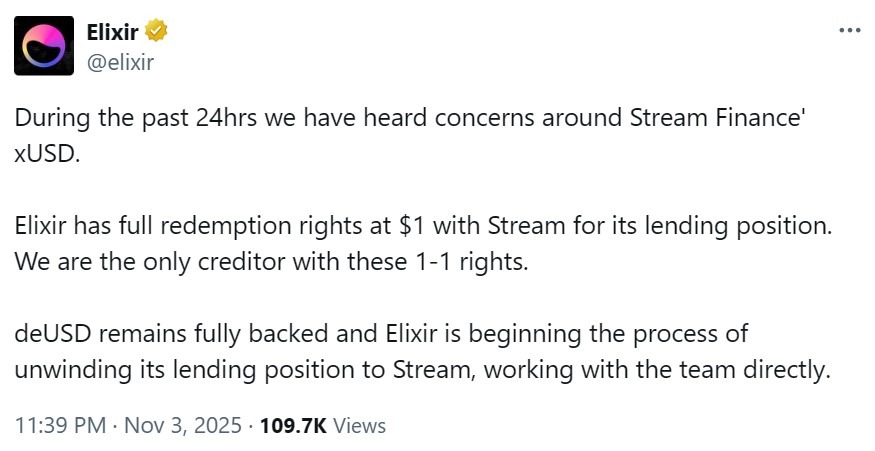Stream Finance’s collapse has exposed over $284 million in DeFi debt across lending markets and stablecoins, involving protocols like Euler, Silo, and Morpho. This intricate web of exposures highlights vulnerabilities in high-yield DeFi infrastructures, with major funds like TelosC and Elixir facing significant losses.
-
Stream Finance paused operations after a $93 million loss from an external fund manager, leading to immediate depegging of its synthetic assets like xUSD.
-
DeFi researchers from Yields and More detailed connections to dozens of vaults and lending platforms, revealing layered risks in stablecoin and loan ecosystems.
-
TelosC holds $123 million in exposure, while Elixir’s $68 million lent to Stream represents 65% of its stablecoin backing, per analysis from DeFi monitoring groups.
Explore the Stream Finance DeFi exposure fallout: $284M in debt loops threaten stablecoins and lenders. Uncover risks and recovery steps in this in-depth analysis. Stay informed on crypto stability today.
What is Stream Finance DeFi Exposure?
Stream Finance DeFi exposure refers to the widespread financial interconnections revealed after the protocol’s collapse, totaling over $284 million in outstanding loans and stablecoin debts across multiple platforms. This exposure stems from synthetic assets like xUSD, xBTC, and xETH that were integrated into lending markets such as Euler, Silo, Morpho, and Gearbox. The collapse, triggered by a $93 million loss attributed to an external fund manager, has paused deposits and withdrawals, amplifying concerns about transparency and risk in decentralized finance.

Source: Elixir
How Does Stream Finance’s Collapse Impact Lending Markets?
The Stream Finance collapse has created complex debt loops involving assets like Elixir’s deUSD and Treeve’s scUSD, affecting at least $284.9 million in overall obligations to lenders. DeFi analysis group Yields and More (YAM) mapped out these connections, noting that protocols such as TelosC face $123 million in material exposure, while Elixir has lent $68 million to Stream, comprising about 65% of its stablecoin reserves. This layered structure—where loans back other loans and stablecoins underpin vaults—complicates loss allocation and recovery efforts.
According to YAM’s detailed report, additional vaults and stablecoins are likely impacted beyond the initial findings, underscoring the opacity in DeFi’s high-yield systems. Elixir has asserted contractual rights to redeem deUSD at a $1 parity, but Stream Finance indicated that repayments are delayed pending legal clarification on creditor priorities. Such delays exacerbate user fears, as evidenced by the rapid depegging of Staked Stream USD (xUSD) from $1 to $0.33, based on market tracking data.
Financial experts in the DeFi space, including those from monitoring firms like DefiLlama, have long warned about these interconnected risks. A quote from a DeFi analyst at a prominent blockchain research firm states, “The Stream incident exemplifies how synthetic assets can propagate failures across ecosystems, demanding better risk assessment tools.” This event reinforces the need for enhanced due diligence in lending protocols, where indirect exposures through secondary strategies could amplify losses beyond the reported figures.
Historically, similar DeFi incidents, such as those involving overleveraged positions in 2022, led to billions in liquidations. Today’s landscape, with total value locked (TVL) in DeFi exceeding $100 billion as of late 2025, shows matured but still fragile infrastructures. Stream’s issues highlight how external managers and unverified TVL discrepancies can erode trust, prompting calls for standardized auditing from bodies like the Ethereum Foundation.
Frequently Asked Questions
What Caused the $93 Million Loss at Stream Finance?
The $93 million loss at Stream Finance resulted from mismanagement by an external fund manager, leading to the protocol pausing all deposits and withdrawals. Investigations by the law firm Perkins Coie are underway to recover assets, though no timeline for resolution has been provided. This incident exposed discrepancies in reported TVL, as noted by DeFi aggregators.
How Can DeFi Users Mitigate Risks from Exposures Like Stream Finance?
To mitigate risks from DeFi exposures similar to Stream Finance, users should diversify across protocols, monitor TVL and peg stability via reliable trackers, and prioritize platforms with audited smart contracts. Natural safeguards include setting stop-losses on synthetic assets and staying updated on cross-protocol dependencies through community reports from groups like YAM.
Key Takeaways
- Interconnected Risks: The $284 million DeFi debt map from YAM reveals how synthetic assets link lending markets, potentially spreading losses through stablecoin loops.
- Major Fund Impacts: TelosC’s $123 million and Elixir’s $68 million exposures demonstrate the scale of institutional involvement in vulnerable DeFi strategies.
- Transparency Imperative: Incidents like Stream’s depegging to $0.33 urge users to verify asset backing and legal recourse before engaging in high-yield opportunities.
Conclusion
The Stream Finance DeFi exposure incident, with its $284 million in tangled debts across stablecoins and lending markets, serves as a stark reminder of the ecosystem’s inherent complexities. As protocols like Euler and Morpho navigate these fallout effects, bolstered transparency and robust legal frameworks will be essential for rebuilding confidence. Looking ahead, DeFi participants should adopt proactive risk management to safeguard against similar collapses, ensuring the sector’s sustainable growth in 2025 and beyond.





